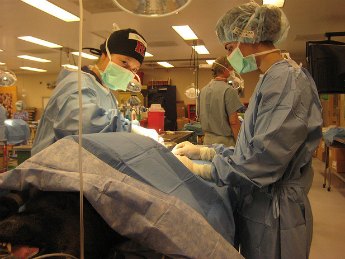Every veterinarian offers basic care such as vaccinations, neuter surgery, and parasite control. But today, just as in human medicine, veterinary specialties offer modern techniques that go “beyond the basics.”
Here are just a few cutting-edge techniques now available to our feline and canine companions. Most are available only in speciality practices and university settings overseas. Ask your veterinarian if these or other procedures might have special benefit for your fur kids.
Back Injury Treatment
An innovative preventive procedure pioneered at Oklahoma State University called laser disk ablations treats dogs with a history of back pain. Instead of surgically removing damaged disks (as in conventional treatment), lasers zap the spinal needles inserted through the skin into the disks, to vaporize the problem material – no incisions, no muss, no fuss – and no disks left to prolapse. A number of specialty veterinary practices in the States now perform this procedure.
Bone Cancer Limb Sparing
Limb-sparing surgeries allow dogs and cats with bone cancer to keep the affected leg, rather than amputating the limb. Surgeons remove only the diseased bone. They then replace it with a donor bone from a deceased companion, or use a living section of bone from a healthy part of the companion’s leg. Other times, a metal rod takes the place of the bone. It takes about sixteen weeks for the graft to fuse to the dog’s existing bone and heal.
And in the most unbelievable medicine of all, the section of radius bone with the offending tumour is removed. Then a 2.5 cm section of healthy bone cut from the stump end is slowly moved 1 mm per day – prompting the healthy bone to grow/heal new bone in about 4 to 6 months.
Vision Surgery
Companions with eye injuries or ulcers benefit from corneal transplants performed by veterinary ophthalmologists. Older dogs may develop problems that cause the cornea to turn blue, and the small central portion is removed and replaced.
Cats sometimes develop eye problems resulting from chronic herpes virus infection that cause the cornea to turn brown and die. A partial thickness corneal graft can correct the defect, and in about six weeks the eye heals and looks clear and beautiful. Companions that develop cataracts also can benefit from the same surgery that treats people.
Kidney Transplants
Kidney transplant can save our companions’ lives. Cats seem particularly accepting of the procedure and do not have the high rejection rate the way dogs and people do. Do not worry, no kitties are killed to provide organs -instead, the feline that donates the kidney gets adopted as part of the arrangement. It has been reported that 59 percent of the cat transplant patients were still alive six months after surgery and 41 percent were still alive three years after surgery – some have lived for a decade or longer. About five universities and private specialty practices in the States offer cat kidney transplants.
Cartilage Transplant and Stem Cell Therapies
Arthritis, dysplasia and other joint problems damage cartilage and make movement painful. An innovative procedure patterned after human techniques harvests healthy normal cartilage (often from the patient’s other joints) and transplants it in plugs in the damaged area. The bone/cartilage plugs grow more cartilage, which spreads and covers the deficit.
Vet-Stem Regenerative Medicine employs a concentrated form of adult stem cells derived from the companion’s own fat tissue to treat tendon, ligament, and arthritic conditions of horses and dogs. The veterinarian collects about two tablespoons of fat from the patient, which is shipped to the Vet-Stem.com laboratory in San Diego, California. Once processed, the stem cells are shipped back to the veterinarian in ready-to-inject syringes, and the stem cell treatment is injected directly into the injured site. Any extra can be stored at the Vet-Stem Bank for future treatments.
Heart Repair
Open-heart surgery currently remains limited to a few universities in US, and UC Davis Veterinary Medical Teaching Hospital is the only place that has regularly scheduled procedures for animals. They can do pretty much any procedure performed on humans, and employ a cardiopulmonary heart-lung bypass machine that allows the heart to be stopped for one to two hours.
One surgical procedure replaces defective valves with cow or pig tissue. Leaking heart valves is common in small animals, especially very small dogs. Surgery requires a six- to nine-person team to carefully monitor the patient before and during the invasive surgery. The entire surgery lasts five hours or longer.
Some dogs now benefit from pacemakers. But the most common congenital heart disease, patent ductus arteriosus (PDA) affects miniature poodles and German shepherds most often. Texas A&M and other specialty practices use catheters (long flexible tube) threaded through the arteries to fix the problem, sometimes by placing stainless steel fibre-embedded coils into the hole. The fibres stimulate clotting, which shuts off the hole.
Research has led to new diagnostic tools, new surgical procedures, new prevention options, and new uses for existing or novel drugs. These innovative veterinary options not only save lives but also extend a companion’s longevity and improve the overall quality of life. And that is just doggone good for everyone!
Adapted from an article by Amy D Shojai




